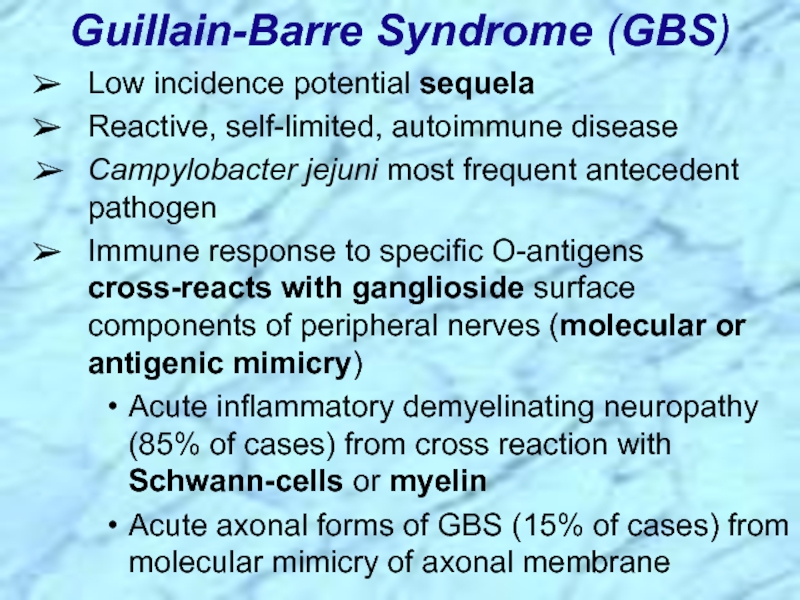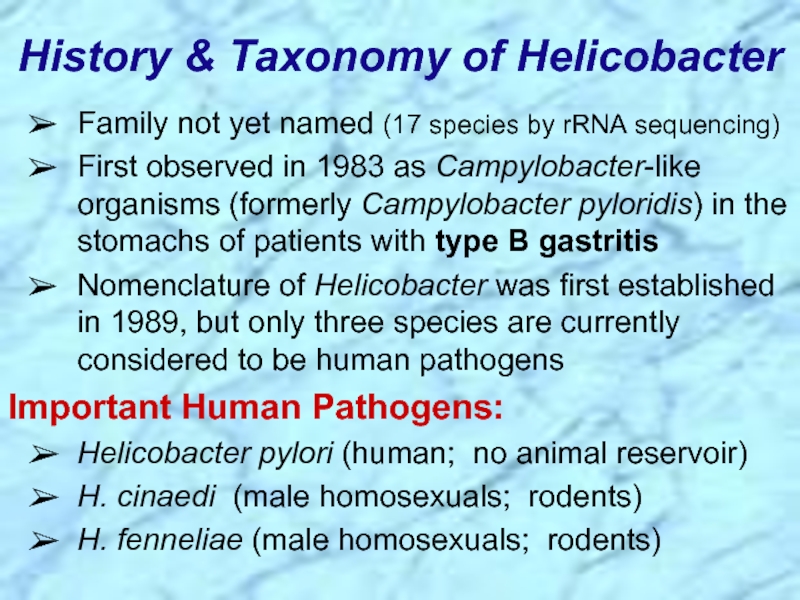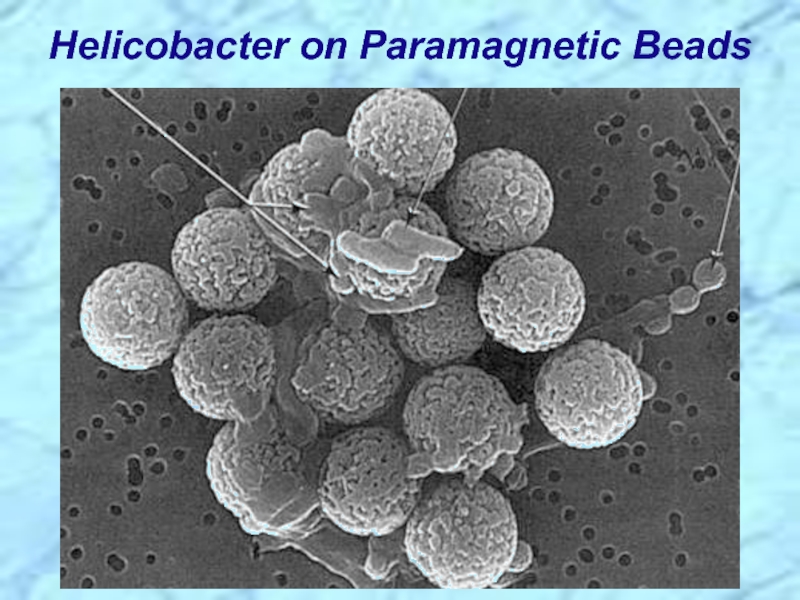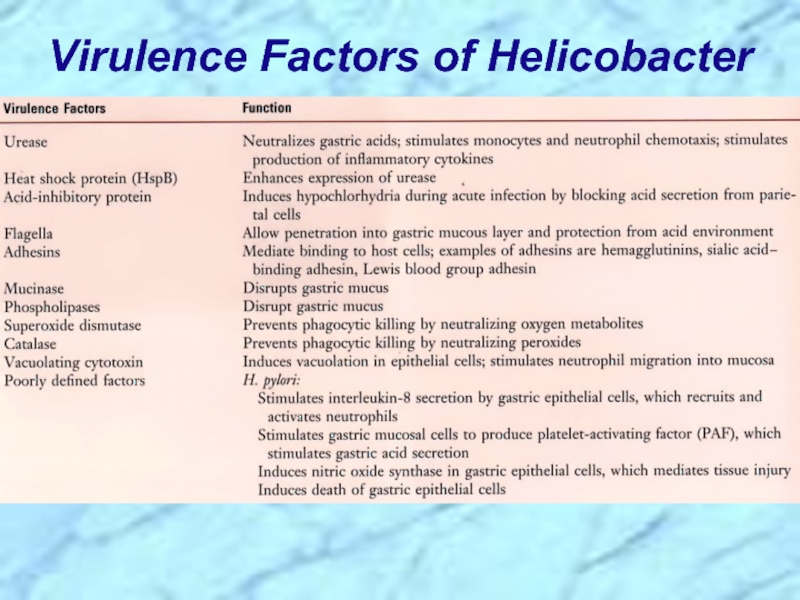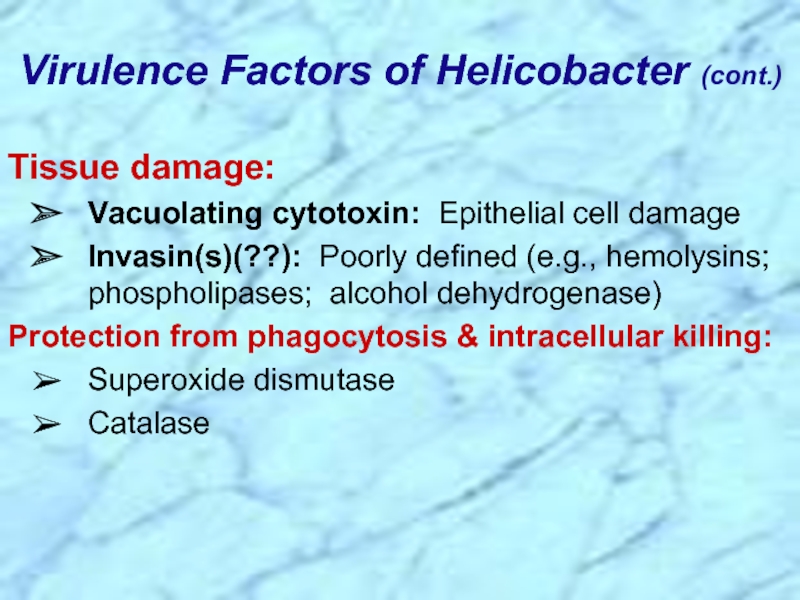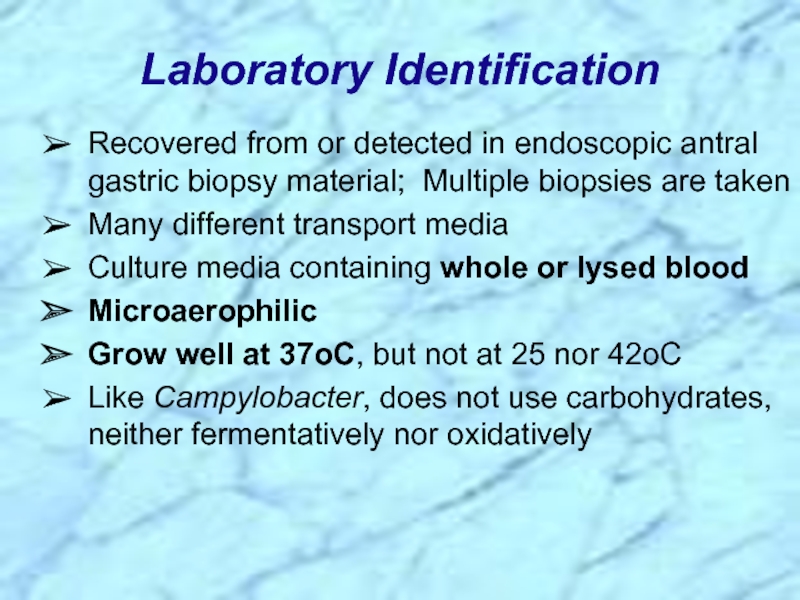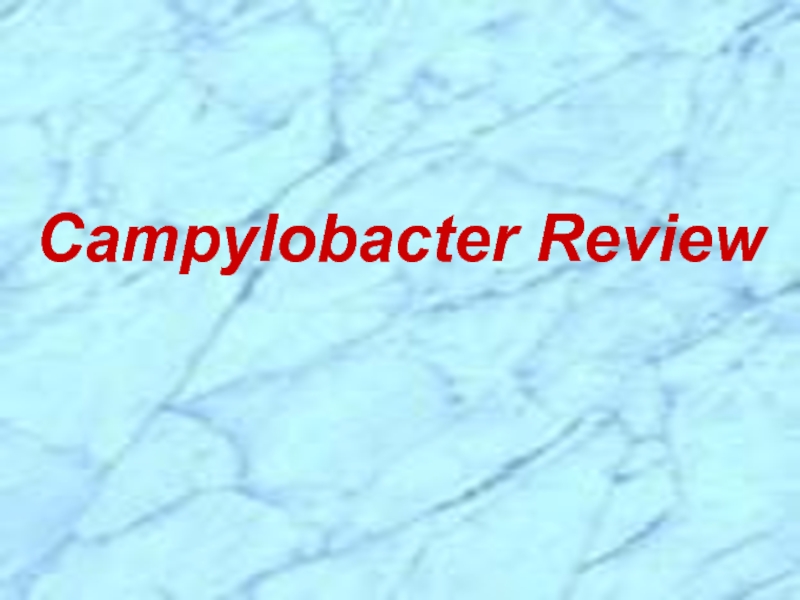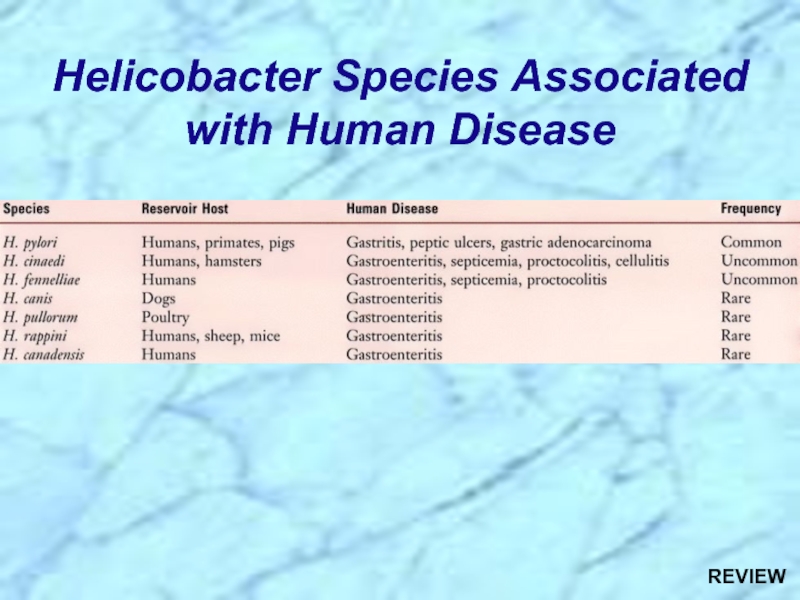- Главная
- Разное
- Дизайн
- Бизнес и предпринимательство
- Аналитика
- Образование
- Развлечения
- Красота и здоровье
- Финансы
- Государство
- Путешествия
- Спорт
- Недвижимость
- Армия
- Графика
- Культурология
- Еда и кулинария
- Лингвистика
- Английский язык
- Астрономия
- Алгебра
- Биология
- География
- Детские презентации
- Информатика
- История
- Литература
- Маркетинг
- Математика
- Медицина
- Менеджмент
- Музыка
- МХК
- Немецкий язык
- ОБЖ
- Обществознание
- Окружающий мир
- Педагогика
- Русский язык
- Технология
- Физика
- Философия
- Химия
- Шаблоны, картинки для презентаций
- Экология
- Экономика
- Юриспруденция
Campylobacter & Helicobacter презентация
Содержание
- 2. rRNA Superfamily VI of Class Proteobacteria
- 3. Gram-negative Helical (spiral or curved) morphology; Tend
- 4. First isolated as Vibrio fetus in 1909
- 5. Small, thin (0.2 - 0.5 um X
- 6. Campylobacter Species Associated with Human Disease
- 7. Low incidence potential sequela Reactive, self-limited, autoimmune
- 8. Zoonotic infections in many animals particularly avian
- 9. Contaminated poultry accounts for more than half
- 10. Sporadic infections in humans far outnumber those
- 12. Infectious dose and host immunity determine whether
- 13. Cellular components: Endotoxin Flagellum: Motility Adhesins: Mediate
- 14. Specimen Collection and Processing: Feces refrigerated
- 15. Laboratory Identification (cont.)
- 16. Gastroenteritis: Self-limiting; Replace fluids and electrolytes
- 18. History & Taxonomy of Helicobacter Family not
- 19. Helicobacter pylori is major human pathogen associated
- 20. Gram-negative; Helical (spiral or curved) (0.5-1.0 um
- 21. Helicobacter on Paramagnetic Beads
- 22. Helicobacter Species Associated with Human Disease
- 23. Family Clusters Orally transmitted person-to-person (?)
- 24. Developed Countries: United States: 30% of total
- 25. Colonize mucosal lining of stomach & duodenum
- 26. Virulence Factors of Helicobacter
- 27. Multiple polar, sheathed flagella Corkscrew motility enables
- 29. Tissue damage: Vacuolating cytotoxin: Epithelial
- 30. Laboratory Identification Recovered from or detected
- 31. Triple Chemotherapy (synergism): Proton pump inhibitor
- 33. REVIEW Campylobacter & Helicobacter Superfamily
- 34. Gram-negative Helical (spiral or curved) morphology; Tend
- 35. Campylobacter Review
- 36. First isolated as Vibrio fetus in 1909
- 37. REVIEW
- 38. REVIEW
- 39. Small, thin (0.2 - 0.5 um X
- 40. Campylobacter Species Associated with Human Disease REVIEW
- 41. Low incidence potential sequela Reactive, self-limited, autoimmune
- 42. Zoonotic infections in many animals particularly avian
- 43. Contaminated poultry accounts for more than half
- 44. Sporadic infections in humans far outnumber those
- 46. Helicobacter Review
- 47. History & Taxonomy of Helicobacter Family not
- 48. Helicobacter pylori is major human pathogen associated
- 49. REVIEW
- 50. REVIEW
- 51. Gram-negative; Helical (spiral or curved) (0.5-1.0 um
- 52. Helicobacter Species Associated with Human Disease REVIEW
- 53. Family Clusters Orally transmitted person-to-person ~ 20%
- 54. Developed Countries: United States: 30% of total
- 55. Colonize mucosal lining of stomach & duodenum
- 56. Virulence Factors of Helicobacter REVIEW
- 57. Triple Chemotherapy (synergism): Proton pump inhibitor
Слайд 3Gram-negative
Helical (spiral or curved) morphology; Tend to be pleomorphic
Characteristics that facilitate
Microaerophilic atmospheric requirements
Become coccoid when exposed to oxygen or upon prolonged culture
Neither ferment nor oxidize carbohydrates
General Characteristics Common to Superfamily
Слайд 4First isolated as Vibrio fetus in 1909 from spontaneous abortions in
Campylobacter enteritis was not recognized until the mid-1970s when selective isolation media were developed for culturing campylobacters from human feces
Most common form of acute infectious diarrhea in developed countries; Higher incidence than Salmonella & Shigella combined
In the U.S., >2 million cases annually, an annual incidence close to the 1.1% observed in the United Kingdom; Estimated 200-700 deaths
History of Campylobacter
Слайд 5Small, thin (0.2 - 0.5 um X 0.5 - 5.0 um),
Tendency to form coccoid & elongated forms on prolonged culture or when exposed to O2
Distinctive rapid darting motility
Long sheathed polar flagellum at one (polar) or both (bipolar) ends of the cell
Motility slows quickly in wet mount preparation
Microaerophilic & capnophilic 5%O2,10%CO2,85%N2
Thermophilic (42-43C) (except C. fetus)
Body temperature of natural avian reservoir
May become nonculturable in nature
Morphology & Physiology of Campylobacter
Слайд 7Low incidence potential sequela
Reactive, self-limited, autoimmune disease
Campylobacter jejuni most frequent antecedent
Immune response to specific O-antigens cross-reacts with ganglioside surface components of peripheral nerves (molecular or antigenic mimicry)
Acute inflammatory demyelinating neuropathy (85% of cases) from cross reaction with Schwann-cells or myelin
Acute axonal forms of GBS (15% of cases) from molecular mimicry of axonal membrane
Guillain-Barre Syndrome (GBS)
Слайд 8Zoonotic infections in many animals particularly avian (bird) reservoirs
Spontaneous abortions in
Humans acquire via ingestion of contaminated food (particularly poultry), unpasteurized milk, or improperly treated water
Infectious dose is reduced by foods that neutralize gastric acidity, e.g., milk. Fecal-oral transmission also occurs
Epidemiology of Campylobacteriosis
Слайд 9Contaminated poultry accounts for more than half of the camylobacteriosis cases
In U.S. and developed countries: Peak incidence in children below one year of age and young adults (15-24 years old)
In developing countries where campylobacters are hyperendemic: Symptomatic disease occurs in young children and persistent, asymptomatic carriage in adults
Epidemiology of Campylobacteriosis(cont.)
Слайд 10Sporadic infections in humans far outnumber those affected in point-source outbreaks
Sporadic
Globally, C. jejuni subsp. jejuni accounts for more than 80% of all Campylobacter enteriti
C. coli accounts for only 2-5% of the total cases in the U.S.; C. coli accounts for a higher percentage of cases in developing countries
Epidemiology of Campylobacteriosis(cont.)
Слайд 12Infectious dose and host immunity determine whether gastroenteric disease develops
Some people
Pathogenesis not fully characterized
No good animal model
Damage (ulcerated, edematous and bloody) to the mucosal surfaces of the jejunum, ileum, colon
Inflammatory process consistent with invasion of the organisms into the intestinal tissue; M-cell (Peyer’s patches) uptake and presentation of antigen to underlying lymphatic system
Non-motile & adhesin-lacking strains are avirulent
Pathogenesis & Immunity
Слайд 13Cellular components:
Endotoxin
Flagellum: Motility
Adhesins: Mediate attachment to mucosa
Invasins
GBS is associated with
S-layer protein “microcapsule” in C. fetus:
Extracellular components:
Enterotoxins
Cytopathic toxins
Putative Virulence Factors
Слайд 14Specimen Collection and Processing:
Feces refrigerated & examined within few hours
Rectal swabs in semisolid transport medium
Blood drawn for C. fetus
Care to avoid oxygen exposure
Selective isolation by filtration of stool specimen
Enrichment broth & selective media
Filtration: pass through 0.45 μm filters
Microscopy:
Gull-wing appearance in gram stain
Darting motility in fresh stool (rarely done in clinical lab)
Fecal leukocytes are commonly present
Identification:
Growth at 25o, 37o, or 42-43oC
Hippurate hydrolysis (C. jejuni is positive)
Susceptibility to nalidixic acid & cephalothin
Laboratory Identification
Слайд 16Gastroenteritis:
Self-limiting; Replace fluids and electrolytes
Antibiotic treatment can shorten the
Azithromycin was effective in recent human clinical trials
Control should be directed at domestic animal reservoirs and interrupting transmission to humans
Guillain-Barre Syndrome (GBS)
Favorable prognosis with optimal supportive care
Intensive-care unit for 33% of cases
Treatment, Prevention & Control
Слайд 18History & Taxonomy of Helicobacter
Family not yet named (17 species by
First observed in 1983 as Campylobacter-like organisms (formerly Campylobacter pyloridis) in the stomachs of patients with type B gastritis
Nomenclature of Helicobacter was first established in 1989, but only three species are currently considered to be human pathogens
Important Human Pathogens:
Helicobacter pylori (human; no animal reservoir)
H. cinaedi (male homosexuals; rodents)
H. fenneliae (male homosexuals; rodents)
Слайд 19Helicobacter pylori is major human pathogen associated with gastric antral epithelium
Stomach of many animal species also colonized
Urease (gastric strains only), mucinase, and catalase positive highly motile microorganisms
Other Helicobacters: H. cinnaedi and H. fenneliae
Colonize human intestinal tract
Isolated from homosexual men with proctitis, proctocolitis, enteritis, and bacteremia and are often transmitted through sexual practices
General Characteristics of Helicobacter
Слайд 20Gram-negative; Helical (spiral or curved) (0.5-1.0 um X 2.5-5.0 um); Blunted/rounded
Produce urease, mucinase, and catalase
H. pylori tuft (lophotrichous) of 4-6 sheathed flagella (30um X 2.5nm) attached at one pole
Single polar flagellum on H. fennellae & H. cinaedi
Smooth cell wall with unusual fatty acids
Morphology & Physiology of Helicobacter
Слайд 23Family Clusters
Orally transmitted person-to-person (?)
Worldwide:
~ 20% below the age of 40
50% above the age of 60 years are infected
H. pylori is uncommon in young children
Epidemiology of Helicobacter Infections
Слайд 24Developed Countries:
United States: 30% of total population infected
Of those, ~1%
~1/3 eventually have peptic ulcer disease(PUD)
70% gastric ulcer cases colonized with H. pylori
Low socioeconomic status predicts H. pylori infection
Developing Countries:
Hyperendemic
About 10% acquisition rate per year for children between 2 and 8 years of age
Most adults infected but no disease
Protective immunity from multiple childhood infections
Epidemiology of Helicobacter Infections (cont.)
Слайд 25Colonize mucosal lining of stomach & duodenum in man & animals
Adherent to gastric surface epithelium or pit epithelial cells deep within the mucosal crypts adjacent to gastric mucosal cells
Mucosa protects the stomach wall from its own gastric milleu of digestive enzymes and hydrochloric acid
Mucosa also protects Helicobacter from immune response
Most gastric adenocarcinomas and lymphomas are concurrent with or preceded by an infection with H. pylori
Pathogenesis of Helicobacter Infections
Слайд 27Multiple polar, sheathed flagella
Corkscrew motility enables penetration into viscous environment (mucus)
Adhesins:
Mucinase: Degrades gastric mucus; Localized tissue damage
Urease converts urea (abundant in saliva and gastric juices) into bicarbonate (to CO2) and ammonia
Neutralize the local acid environment
Localized tissue damage
Acid-inhibitory protein
Virulence Factors of Helicobacter
Слайд 28
C=O(NH2)2 + H+ + 2H2O → HCO3- + 2 (NH4+)
Urea Bicarbonate Ammonium ions
And then… HCO3- → CO2 + OH-
Urea Hydrolysis
Слайд 29Tissue damage:
Vacuolating cytotoxin: Epithelial cell damage
Invasin(s)(??): Poorly defined (e.g.,
Protection from phagocytosis & intracellular killing:
Superoxide dismutase
Catalase
Virulence Factors of Helicobacter (cont.)
Слайд 30Laboratory Identification
Recovered from or detected in endoscopic antral gastric biopsy
Many different transport media
Culture media containing whole or lysed blood
Microaerophilic
Grow well at 37oC, but not at 25 nor 42oC
Like Campylobacter, does not use carbohydrates, neither fermentatively nor oxidatively
Слайд 31
Triple Chemotherapy (synergism):
Proton pump inhibitor (e.g., omeprazole = Prilosec(R))
One or more
Bismuth compound
Inadequate treatment results in recurrence of symptoms
Treatment, Prevention & Control
Слайд 34Gram-negative
Helical (spiral or curved) morphology; Tend to be pleomorphic
Characteristics that facilitate
Microaerophilic atmospheric requirements
Become coccoid when exposed to oxygen or upon prolonged culture
Neither ferment nor oxidize carbohydrates
General Characteristics Common to Superfamily
REVIEW
Слайд 36First isolated as Vibrio fetus in 1909 from spontaneous abortions in
Campylobacter enteritis was not recognized until the mid-1970s when selective isolation media were developed for culturing campylobacters from human feces
Most common form of acute infectious diarrhea in developed countries; Higher incidence than Salmonella & Shigella combined
In the U.S., >2 million cases annually, an annual incidence close to the 1.1% observed in the United Kingdom; Estimated 200-700 deaths
History of Campylobacter
REVIEW
Слайд 39Small, thin (0.2 - 0.5 um X 0.5 - 5.0 um),
Tendency to form coccoid & elongated forms on prolonged culture or when exposed to O2
Distinctive rapid darting motility
Long sheathed polar flagellum at one (polar) or both (bipolar) ends of the cell
Motility slows quickly in wet mount preparation
Microaerophilic & capnophilic 5%O2,10%CO2,85%N2
Thermophilic (42-43C) (except C. fetus)
Body temperature of natural avian reservoir
May become nonculturable in nature
Morphology & Physiology of Campylobacter
REVIEW
Слайд 41Low incidence potential sequela
Reactive, self-limited, autoimmune disease
Campylobacter jejuni most frequent antecedent
Immune response to specific O-antigens cross-reacts with ganglioside surface components of peripheral nerves (molecular or antigenic mimicry)
Acute inflammatory demyelinating neuropathy (85% of cases) from cross reaction with Schwann-cells or myelin
Acute axonal forms of GBS (15% of cases) from molecular mimicry of axonal membrane
Guillain-Barre Syndrome (GBS)
REVIEW
Слайд 42Zoonotic infections in many animals particularly avian (bird) reservoirs
Spontaneous abortions in
Humans acquire via ingestion of contaminated food (particularly poultry), unpasteurized milk, or improperly treated water
Infectious dose is reduced by foods that neutralize gastric acidity, e.g., milk. Fecal-oral transmission also occurs
Epidemiology of Campylobacteriosis
REVIEW
Слайд 43Contaminated poultry accounts for more than half of the camylobacteriosis cases
In U.S. and developed countries: Peak incidence in children below one year of age and young adults (15-24 years old)
In developing countries where campylobacters are hyperendemic: Symptomatic disease occurs in young children and persistent, asymptomatic carriage in adults
Epidemiology of Campylobacteriosis(cont.)
REVIEW
Слайд 44Sporadic infections in humans far outnumber those affected in point-source outbreaks
Sporadic
Globally, C. jejuni subsp. jejuni accounts for more than 80% of all Campylobacter enteriti
C. coli accounts for only 2-5% of the total cases in the U.S.; C. coli accounts for a higher percentage of cases in developing countries
Epidemiology of Campylobacteriosis(cont.)
REVIEW
Слайд 47History & Taxonomy of Helicobacter
Family not yet named (17 species by
First observed in 1983 as Campylobacter-like organisms (formerly Campylobacter pyloridis) in the stomachs of patients with type B gastritis
Nomenclature of Helicobacter was first established in 1989, but only three species are currently considered to be human pathogens
Important Human Pathogens:
Helicobacter pylori (human; no animal reservoir)
H. cinaedi (male homosexuals; rodents)
H. fenneliae (male homosexuals; rodents)
REVIEW
Слайд 48Helicobacter pylori is major human pathogen associated with gastric antral epithelium
Stomach of many animal species also colonized
Urease (gastric strains only), mucinase, and catalase positive highly motile microorganisms
Other Helicobacters: H. cinnaedi and H. fenneliae
Colonize human intestinal tract
Isolated from homosexual men with proctitis, proctocolitis, enteritis, and bacteremia and are often transmitted through sexual practices
General Characteristics of Helicobacter
REVIEW
Слайд 51Gram-negative; Helical (spiral or curved) (0.5-1.0 um X 2.5-5.0 um); Blunted/rounded
Produce urease, mucinase, and catalase
H. pylori tuft (lophotrichous) of 4-6 sheathed flagella (30um X 2.5nm) attached at one pole
Single polar flagellum on H. fennellae & H. cinaedi
Smooth cell wall with unusual fatty acids
Morphology & Physiology of Helicobacter
REVIEW
Слайд 53Family Clusters
Orally transmitted person-to-person
~ 20% below the age of 40 years
50% above the age of 60 years are infected
H. pylori is uncommon in young children
Epidemiology of Helicobacter Infections
REVIEW
Слайд 54Developed Countries:
United States: 30% of total population infected
Of those, ~1%
~1/3 eventually have peptic ulcer disease(PUD)
70% gastric ulcer cases colonized with H. pylori
Low socioeconomic status predicts H. pylori infection
Developing Countries:
Hyperendemic
About 10% acquisition rate per year for children between 2 and 8 years of age
Most adults infected but no disease
Protective immunity from multiple childhood infections
Epidemiology of Helicobacter Infections (cont.)
REVIEW
Слайд 55Colonize mucosal lining of stomach & duodenum in man & animals
Adherent to gastric surface epithelium or pit epithelial cells deep within the mucosal crypts adjacent to gastric mucosal cells
Mucosa protects the stomach wall from its own gastric milleu of digestive enzymes and hydrochloric acid
Mucosa also protects Helicobacter from immune response
Most gastric adenocarcinomas and lymphomas are concurrent with or preceded by an infection with H. pylori
Pathogenesis of Helicobacter Infections
REVIEW
Слайд 57
Triple Chemotherapy (synergism):
Proton pump inhibitor (e.g., omeprazole = Prilosec(R))
One or more
Bismuth compound
Inadequate treatment results in recurrence of symptoms
Treatment, Prevention & Control
REVIEW






